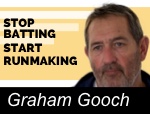|

Last week we looked at the importance of "golden moments" in coaching. There are a heap of individual moments for a coach and a player in a game of cricket. I am going to focus on one such opportunity today: When a wicket falls.
The time when I see most coach-player interaction directly ahead of performance comes when a wicket falls. The incoming batter on puts on their helmet and gloves before standing up and walking to the wicket.
You may get 10 seconds to add value to a players performance.
What considerations should we take to shape our interactions?
Know your player
Have you noticed how some players like to sit quietly and watch the game whilst others love the interactions with fellow team mates ahead of their innings? These players display behaviours that may give us an insight into what they need in any "golden moment" coaching opportunity.
The "introverted player" is often working things out for themselves as they watch. Their quiet exterior belies the activity that is occurring in their heads.
Often, these guys need a simple question, something like,
"How do you see the game?".
The question will provide the stimulus for the externalisation of their inner thoughts.
On the other hand, the "chatterer" appears to lack focus, yet this isn't always the case.
They often have more plans than the quieter player. In this case, the role of the coach is to limit those to a manageable number thus increasing clarity when the player gets to the wicket:
"What is the key thing for you to focus on at the outset of the innings?"
In many cases, the best communication between player and coach can be non-verbal.
Because you have worked hard with the players ahead of game day, often, the work has been done, the plans are clear and all the player is looking for from the coach is either a trusting glance, a slight hand gesture or in some cases no interaction at all.
Some of the best coaching in this golden moment is doing nothing at all.
Duncan Fletcher was a master at choosing the right approach for each player and each moment. His preference was to do or say nothing unless he could add value. If Fletch was to intervene in a golden moment then it would be so minimal yet so impactful.
As England coach in the 2000s, his relationship with star players like Trescothick, Vaughan, Collingwood and Strauss was so strong that a squeeze of the shoulder or a little glance would provide the extra confidence or clarity that each player required walking to the wicket.
Use your golden moment wisely
To judge what is required accurately and appropriately is ultimately the art of the coaching; the art of the golden moment. Fletcher was a master at this and with lots of practice, you can become masterful too.
So before you act, think about how best to add value to that moment. Think about what the player needs. And remember that doing nothing can sometimes be the best way of adding value.
Discuss this article with other subscribers
|

.jpg)

.jpg)

.jpg)

.jpg)